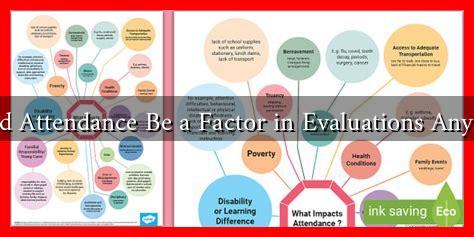-
Table of Contents
Should Attendance Be a Factor in Evaluations Anymore?
In the modern workplace, the debate over whether attendance should be a factor in employee evaluations has gained significant traction. With the rise of remote work, flexible schedules, and a growing emphasis on results over hours spent in the office, many organizations are re-evaluating traditional metrics of employee performance. This article explores the implications of attendance as a performance metric, examining its relevance in today’s work environment.
The Traditional View of Attendance
Historically, attendance has been a cornerstone of employee evaluations. Employers often viewed consistent attendance as a sign of commitment and reliability. The traditional arguments for attendance as a performance metric include:
- Dependability: Regular attendance is often equated with dependability, suggesting that employees who show up consistently are more likely to meet deadlines and contribute to team goals.
- Team Dynamics: In collaborative environments, attendance can impact team cohesion and productivity. Missing team members can disrupt workflows and hinder project progress.
- Workplace Culture: A culture that values attendance may foster a sense of accountability and responsibility among employees.
However, as work environments evolve, the relevance of attendance as a performance metric is increasingly being questioned.
The Case Against Attendance as a Performance Metric
Critics of using attendance as a factor in evaluations argue that it does not accurately reflect an employee’s contributions or capabilities. Here are some compelling reasons to reconsider attendance as a performance metric:
- Focus on Results: Many organizations are shifting towards a results-oriented approach, where the quality of work and outcomes are prioritized over the number of hours spent in the office.
- Remote Work Flexibility: The COVID-19 pandemic accelerated the adoption of remote work, demonstrating that employees can be productive outside traditional office settings. A study by Stanford University found that remote workers were 13% more productive than their in-office counterparts.
- Employee Well-being: Rigid attendance policies can negatively impact employee morale and mental health. Employees may feel pressured to come to work even when unwell, leading to burnout and decreased productivity.
Case Studies and Statistics
Several organizations have successfully moved away from attendance-based evaluations, yielding positive results:
- Atlassian: The software company implemented a results-oriented work environment (ROWE) where employees are evaluated based on their output rather than their presence. This shift led to increased employee satisfaction and productivity.
- Buffer: Buffer, a social media management platform, adopted a flexible work policy that emphasizes results. The company reported higher employee engagement and retention rates as a result.
Statistics also support the argument against attendance as a performance metric. According to a Gallup poll, 87% of employees worldwide are not engaged at work, often due to outdated evaluation methods that prioritize attendance over performance.
Finding a Balance
While attendance may not be the best metric for evaluating employee performance, it is essential to find a balance. Here are some strategies organizations can adopt:
- Implement Flexible Work Policies: Allow employees to choose their work hours and locations, focusing on results rather than hours logged.
- Set Clear Performance Metrics: Establish specific, measurable goals that align with organizational objectives, allowing employees to understand what is expected of them.
- Encourage Open Communication: Foster a culture where employees feel comfortable discussing their needs and challenges, promoting a healthier work environment.
Conclusion
As the workplace continues to evolve, the relevance of attendance as a factor in employee evaluations is increasingly being challenged. While attendance has traditionally been viewed as a measure of reliability and commitment, it does not necessarily reflect an employee’s true contributions or potential. Organizations that prioritize results, employee well-being, and flexible work arrangements are likely to see improved productivity and engagement. By moving away from rigid attendance policies and focusing on performance metrics that truly matter, companies can create a more dynamic and effective workforce.
For further reading on modern workplace evaluations, consider exploring resources from the Society for Human Resource Management (SHRM) at SHRM.

